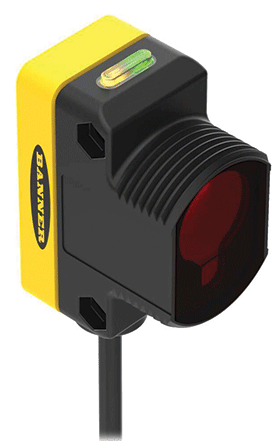
Detecting and counting clear bottles in pharmaceutical, food and beverage applications has been a difficult sensing challenge. With traditional photoelectric sensors the sensing beam may burn through translucent materials, or the emitted light may reflect off the bottle, resulting in unreliable counting results. Ultrasonic sensors can be used to detect clear objects reliably, but ultrasonic solutions may not have a fast enough response time, and the ultrasonic beam is usually too wide to detect the gaps between bottles. A solution is needed that will reliably count clear bottles as they pass on a conveyor, and is sensitive to the small gaps between targets.
The World-Beam QS30 clear object sensor from Turck Banner has been created specifically to detect and count clear objects reliably. The optical design of the QS30 controls how the emitted light strikes the reflector. The stable and controlled optical path allows the sensor’s microcontroller to detect small changes in the light level. Additionally, the fast 500 microsecond response time makes the sensor able to detect and count the clear bottles as they quickly pass on the conveyor.

For counting applications, the switching threshold is based on the amount of light received by the sensor as the gap between the bottles passes through the light beam. To configure this application, the sensor is aligned to the retroreflector, and the bottles are positioned so that the beam is passing through the gap between the bottles. A Light SET is then performed to teach the sensor the expected light level it should receive from the retroreflector. The user selects a switch point, either 8% (clear), 16% (medium) or 32% (dark) below this taught light level. All conditions darker than this selected switch point will trigger an output.
In this application, the sensor’s automatic compensation algorithm should be disabled to prevent the sensor from adjusting to the brighter light level it receives when no bottle is present. It is advised to select the darkest switch point which reliably detects the bottle. The medium level will work for most applications. Dark level may provide more robust detection under difficult environmental conditions such as dust and vibration.
The QS30 clear object sensor has an innovative 30 mm housing to suit any mounting requirement, and has IP67 or IP69K environmental rating, depending on the model. Not only does it have a high power sensing range of 200 metres, but it is also easily configurable, using either the push button on the sensor or via a remote input line. It includes bright LED operating status indicators visible from 360° for easy identification.
| Tel: | +27 11 453 2468 |
| Email: | [email protected] |
| www: | www.turckbanner.co.za |
| Articles: | More information and articles about Turck Banner Southern Africa |

© Technews Publishing (Pty) Ltd | All Rights Reserved